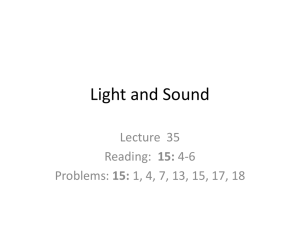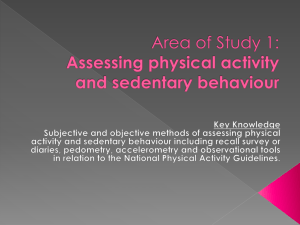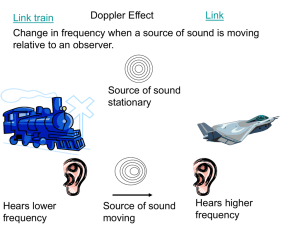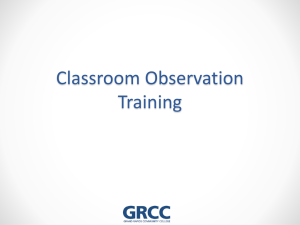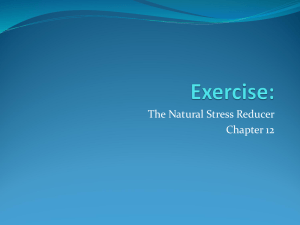16.6 The Speed of Sound - Physics-YISS
advertisement
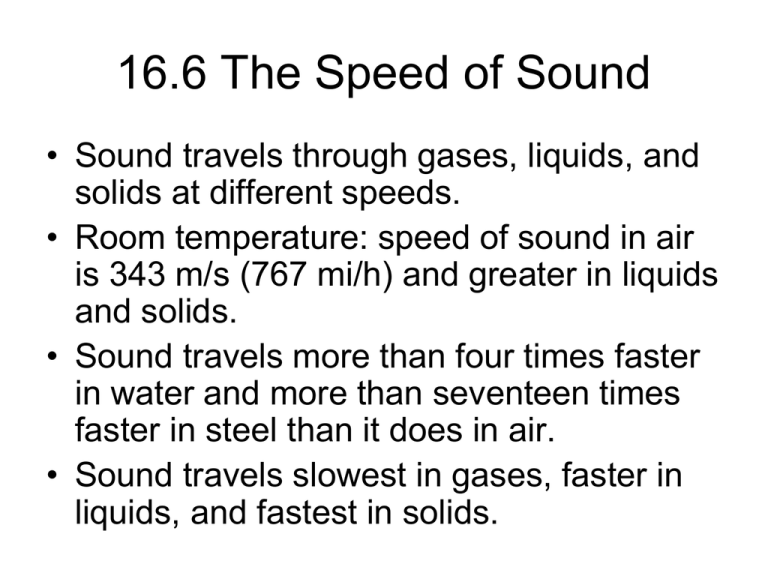
16.6 The Speed of Sound • Sound travels through gases, liquids, and solids at different speeds. • Room temperature: speed of sound in air is 343 m/s (767 mi/h) and greater in liquids and solids. • Sound travels more than four times faster in water and more than seventeen times faster in steel than it does in air. • Sound travels slowest in gases, faster in liquids, and fastest in solids. • Issac Newton was the first to measure sound. • http://www.youtube.com/watch?v=PzUU4 G4uW18&feature=related Sound in a gas • Only when molecules collide that the condensations and rarefactions of a sound wave can move from place to place. • Speed of sound in a gas to have the same order of magnitude as the average molecular speed between collisions. Speed in Ideal Gas • Translational rms (root mean square) speed given in the following equation 14.6 T = Kelvin M = mass k = Boltzmann’s constant (relation between absolute temp. and the KE contained in each molecule of an ideal gas) Overestimates the speed of sound. It gives the correct dependence on Kelvin temperature and particle mass. Speed of sound in an ideal gas (16.5) y = cp/cv ratio of specific heat capacity at constant pressure cp to the specific heat capacity at constant volume cv. (adiabatic) Ideal monatomic gas: y = 5/3 (atoms are not bonded together) Y = 7/5 for ideal diatomic gases (composed of 2 atoms) Y is here because the condensations and rarefactions of a sound wave are formed by adiabatic compressions (impassable) and expansions of the gas. Example 4: An Ultrasonic Ruler Practice Problem 44 Homework • Pg. 506 • Ques. 29, 30, 31 Sonar • Sound navigation ranging • Used to determine water depth and locating underwater objects, such as reefs, submarines, and schools of fish. • Ultrasonic transmitter and receiver mounted on the bottom of a ship. • Transmitter emits a short pulse of ultrasonic sound, later the reflected pulse returns and is detected by the receiver. • Depth determined the time it took for the sound to return. http://www.youtube.com/watch?v=Xc2EZjG0b8U &feature=related Liquids • In a liquid, the speed of sound depends on the density p and the adiabatic bulk modulus Bad of the liquid: (16.6) Liquids • Adiabatic bulk modulus Bad (substance's resistance to uniform compression) is used when calculating the speed of sound in liquids. • In seawater sound is 1522m/s (4x greater than in air). In Medicine • Ultrasonic probe called an A-scan is used to measure the length of the eyeball in front of the lens, thickness of the lens, and the length of the eyeball between the lens and the retina. • Needed information is the speed of sound in the material in front of and behind the lens of the eye is 1532m/s and that within the lens is 1641m/s. Solid Bars • When sound travels through a long slender solid bar, the speed of the sound depends on the properties of the medium according to 16.7 Sound Intensity • Sound waves carry energy that can be used to do work. • Sonic boom: can carry enough energy to cause damage to windows and buildings. • The amount of energy transported per second by a sound wave is called the power of the wave and is measure in SI units of joules per second (J/s) or watts (W). • http://www.youtube.com/watch?v=QX04yS m4TTk&feature=related • http://www.youtube.com/watch?v=kUm5EiaAxo&feature=related • http://www.youtube.com/watch?v=PMg_nd -O688 Sound Intensity I • Power spreads out as it leaves the source. • It spreads out but has the same power even when spread out over a greater area. • Sound Intensity I: sound power P that passes perpendicularly through a surface divided by the area A of that surface: Example 6: Sound Intensities • The sound intensity is less at the more distant surface, where the same power passes through a threefold greater area. The ear of a listener, with its fixed area, intercepts less power where the intensity, or power per unit area, is smaller. Thus listener 2 intercepts less of the sound power than listener 1. With less power striking the ear, the sound is quieter. Threshold of Hearing • For a 1000Hz tone, the smallest sound intensity that the human ear can detect is about 1x10^-12W/m2. (threshold of hearing) • Intensities greater than 1 W/m2 can be painful and result in permanent hearing damage if continuously exposed to them. • A source emits sound uniformly in all directions, the intensity depends on distance. • If the source is at the center of an imaginary sphere. The radius of the sphere is r. Since all the radiated sound power P passes through the spherical surface of A = , the intensity at a distance r is. Example 7: Fireworks 16.8 Decibels • Measurement unit used when comparing two sound intensities. • Io is the intensity of the reference level to which I is being compared and is often the threshold of hearing. • Threshold of hearing: Io = 1.00x10^-12W/m^2 Smallest sound a human ear can detect. • I is 9dB greater than Io. • B is called the intensity level, it is not an intensity and does not have intensity units of W/m^2. • Decibel is dimensionless. • What if I = Io? • 0dB • Doesn’t mean sound intensity is zero. • The sound is interpreted by the brain as loud or soft, depending on the intensity of the wave. • Greater intensities --- louder the sound. • Though doubling the intensity does not double the loudness. • 1dB change in intensity level creates a small change in loudness to an average listener. Example 9: Comparing Sound Intensities • To double the loudness of a sound the intensity must be increased by more than a factor of two. • Intensity level increases by 10dB, the new sound seems approximately twice as loud as the original sound. • 70dB seems twice as loud as 60dB • http://www.youtube.com/watch?v=NcAeK0 yz_Fk Practice Problem 59. An amplified guitar has a sound intensity level that is 14 dB greater than the same unamplified sound. What is the ratio of the amplified intensity to the unamplified intensity? 16.9 The Doppler Effect • When the source approaches the pitch is high, as the sources passes the pitch suddenly drops. • Austrian physicist Christian Doppler Doppler effect • Change in frequency or pitch of the sound detected by an observer because the sound source and the observer have different velocities with respect to the medium of sound propagation. Moving Source • As the source is approaching the condensations of sound are now closer together, resulting in a decrease in the wavelength of the sound. • “bunching up” occurs because the moving truck “gains ground” on a previously emitted condensation before emitting the next one. • Condensations are closer together, the observer standing in front of the truck senses more of them arriving per second (greater frequency) • Behind the moving source the condensations are farther apart than they are when the truck is stationary. • Increase in wavelength; lowers frequency; lower pitch. • Vs = velocity of the source of sound • VsT = the distance the source moves closer or away to the observer. • The distance between successive condensations is no longer the wavelength but is the wavelength that is shortened or lengthened by the amount VsT. • Frequency perceived by the stationary observer as Fo, where the subscript “o” stands for “observer” • Fo is equal to the speed of sound V divided by the shortened wavelength. • Expression for Fo can be arranged to give the following result: Fo – Fs = Doppler Shift Magnitude depends on the ratio of the speed of the source Vs to the speed of the sound V. When the siren moves away from, rather than toward, the observer, the wavelength becomes greater than the original wavelength. Source moving away from stationary observer. • http://www.fearofphysics.com/Sound/dopw hy1.html Example 10: The Sound of a Passing Train A high-speed train is traveling at a speed of 44.7 m/s when the engineer sounds the 415Hz warning horn. The speed of sound is 343m/s. What are the frequency and wavelength of the sound, as perceived by a person standing at a crossing, when the train is (a) approaching and (b) leaving the crossing? Moving Observer • Sound source is stationary • Observer moves • Vot = distance covered by observer • Observer encounters mover condensations. Distance /distance of wavelength Observer moving toward stationary source. • Observer moving away from stationary source General Case • Both the sound source and the observer are moving with respect to the medium of sound propagation. • Medium is stationary Eq. 16.11-16.14 are combined Source and Observer both moving In Numerator: • Plus sign when the observer moves toward the source. • Minus sign when the observer moves away the source. In Denominator: • Minus sign when the source moves toward the observer. • Plus sign when the source moves away from the observer. In class partner open book quiz.

